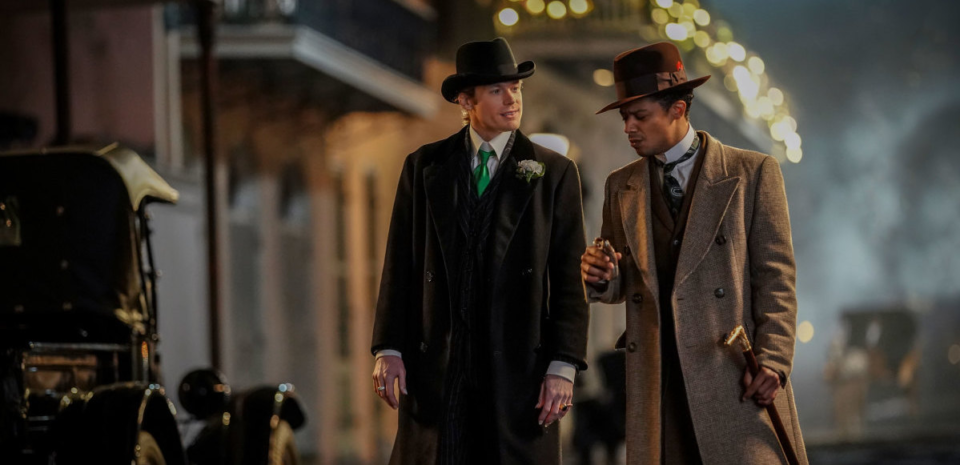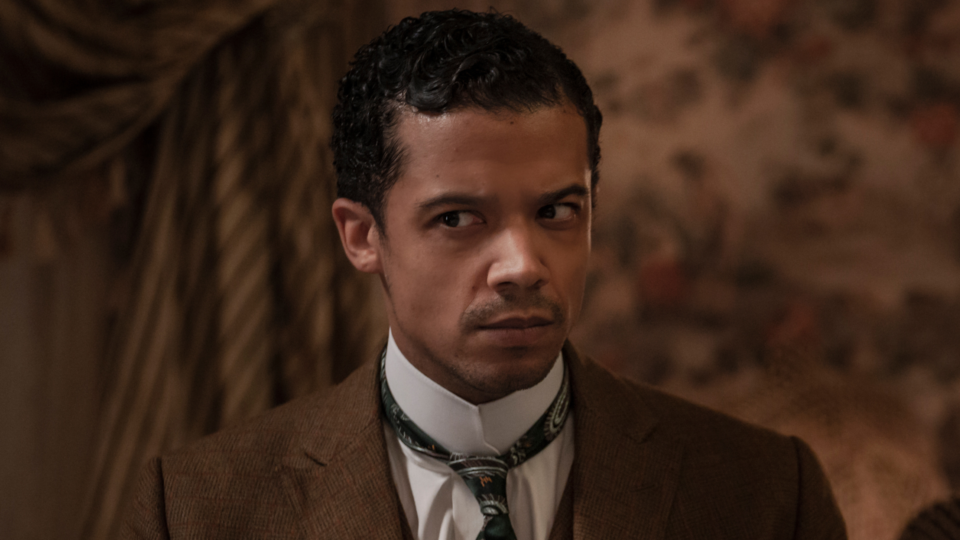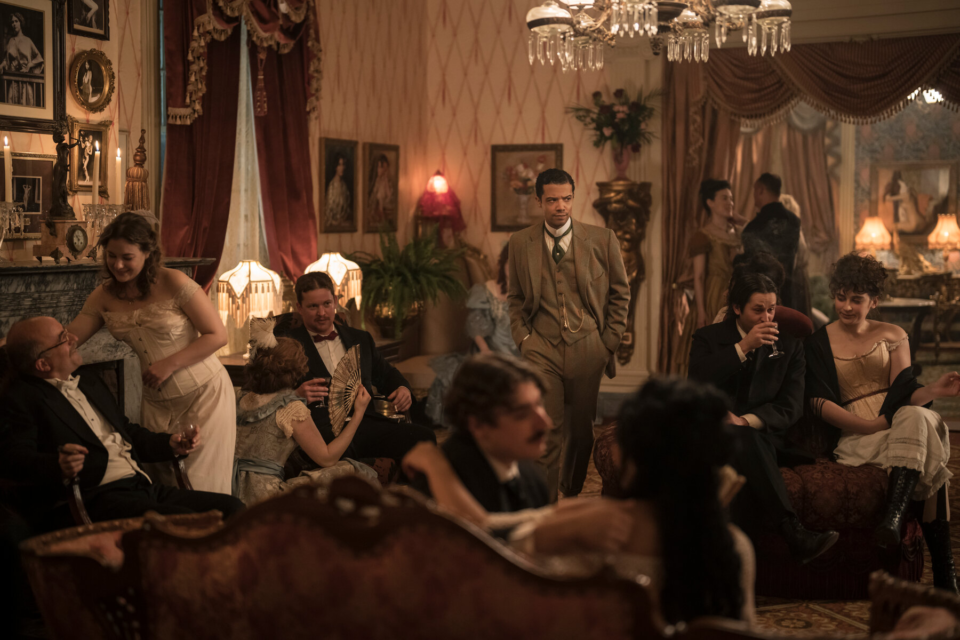Lestat and His Pets: A Look At ‘Interview With The Vampire’ (2022)

Anne Rice’s novel Interview With The Vampire was published in 1976 and was written in a little over a month. Currently, about 8 million copies have been sold worldwide. For my fellow vampire lovers, we don’t get gems like the House of Night series or anti-hero vamps like Klaus Mikaelson (Vampire Diaries and The Originals) without Anne Rice’s Lestat de Lioncourt. She is the mother of the hate-to-love-them vampires and the literary and film worlds miss her.
With well-deserved respects paid, let’s get into it!
Almost two decades after the book was published, Interview With The Vampire was adapted into a movie. The 1994 production starred Tom Cruise as Lestat de Lioncourt, Brad Pitt as Louis de Pointe Du Lac, and a young Kirsten Dunst as their adopted daughter turned child vampire, Claudia. Now, almost three decades after the movie, AMC released a series of the same name with Sam Reid as Lestat, Jacob Anderson as Louis, and Bailey Bass as Claudia.
These adaptations of Anne Rice’s story are both fairly successful, but with distinct differences between them. One difference you can’t help but notice within the first 10 minutes of the pilot is Louis de Pointe du Lac is a Black man. It was right there that I had to pump the brakes, hit pause, and make sure I was watching the right show. For those who may not know, in the film (and the novel), Louis was a white plantation owner when he met Lestat. So, it was a bit of a shock to see Louis’ change in race.
Not that I’d ever complain about seeing a beautiful Black vampire on my screen. I miss you, Marcellus Gerard.
This change in race immediately alters the power dynamic between Lestat and Louis. In the film, they were both white men of seemingly high prestige and money so their ability to move in society was equal. The Interview With The Vampire series making Louis a Black character in 1910 causes a huge shift in power, in Lestat’s favor. Louis is a trapped bird from the beginning simply because Lestat has more social currency than him, even as a stranger.
Louis’ lifestyle is more luxurious than most Black men’s at that time. But, it is also very delicate, hanging in the balance by the opinion of white men. Even the alderman who “respects” Louis loses his temper and calls him a slur at one point, reminding Louis that even though he is a well-known and sought-after man, he is one person’s bad mood from being ruined. Louis painstakingly built an empire that Lestat proves to have little care for, given his privilege allows him to move how he pleases through the world.

But Louis’ race change isn’t the series’ only change. The series also shifts the time period. In the film, Louis met Lestat in 1791. But being that Louis is a Black man and there was no world where a Black man was free in 1791 New Orleans, the time period that the story starts in the show is 1910 New Orleans. Instead of being a plantation owner with slaves, Louis is the owner of pleasure houses in New Orleans’ “Red Light District” in the town of Storyville; the third major difference between the movie and the show.
Louis, essentially, owns these women and like the film version of Louis, he seems to be kind enough to his property. His profession as a pimp is what allows him to have a similar amount of power and prestige as the film version while also giving him a level of intelligence the film version did not have. Louis in the film was a plantation owner simply by inheritance and we don’t see exactly how well business is going for him so it’s hard to say if he is especially intelligent or not. In the film, Louis allows things to happen to him, never really being the mastermind behind anything.
In the Interview With The Vampire series, Louis shows more teeth and he deserves respect simply for thriving in a business as a Black man in 1910 New Orleans. Their family business was in sugarcane, descended from the work of slaves, but according to Louis, his father ran their business into the ground. So, it is understood that Louis built this business from the ground up, finding a desire in society and carving his spot in that industry as a provider.
In the pilot, you also learn that Louis is queer as modern-day Louis retells his story to the journalist, Daniel Molloy. Specifically, he says he did not describe himself as a homosexual back in 1910 but eventually accepted his sexuality. In the film, there was the understanding that the two men lived together but there was never anything that could explicitly confirm they were in a romantic relationship. The Interview With The Vampire series took that and dove right in; there is no denying this Lestat and Louis are lovers.

This is yet another societal strike against Louis that Lestat does not care about. Being a rich and famous Black man already puts a target on Louis’ back. But being queer only makes that target larger and Lestat does not recognize that very real threat to Louis’ life, further pushing the power in Lestat’s favor. Lestat has no problem murdering anyone who would have anything to say but Louis cares about his image, New Orleans, and his clientele. This makes Louis more and more vulnerable in his relationship with Lestat.
Later on in Interview With The Vampire when you meet their baby vampire, Claudia, you’ll notice she too is highly melanated in comparison to her original movie portrayal. Louis and Claudia both being Black creates a delicate and interesting power dynamic in the show that didn’t exist in the movie. All these added layers make for fuller characters and stories that you can’t help but be sucked into.
First and foremost, Lestat in the show is a textbook abuser. Tom Cruise’s version of Lestat was more of a socialite playboy, Louis’ rambunctious frat brother. But Sam Reid’s Lestat is a manipulative and calculating predator who has his sights set on the unsuspecting Louis. Positioning the story in 1910 with Louis as a rich and successful Black business owner creates the first level of pressure that Lestat takes advantage of. Naturally, being a Black man in 1910 with money did not come without its challenges (you will hear the HARD R in this show) and Louis had to stomach varying levels of disrespect in order to keep politicians, aldermen, and other high-society nobility in his pleasure houses and their money in his pockets.

Lestat sees this and wastes no time exploiting that uneasy feeling in Louis’ stomach, toying with his mind and challenging why he accepts unfair treatment. As if Louis has any other choice. Lestat plants his first seed of desire in Louis’ mind that he’ll harvest later when he gives Louis the illusion of having a choice to be turned into a vampire.
One of the things the show really gets my love for is not making Louis a small man. In the movie, Louis is not very outspoken and kind of just allows things to happen to him. In the show, Louis is a force to be reckoned with and challenges Lestat, even as a human. He may not have known Lestat’s true nature but he knew there was something powerful about him. Yet that never made Louis back down. It did however entice Lestat further.
Lestat hunted Louis, a strong Black man, by wearing him down and chipping away at him piece by piece, and calling that love. Louis started off as an angry, forceful man, someone who built his business in a much less than ideal environment but even the strongest person can not withstand the type of mental abuse Lestat made Louis endure. Lestat definitely grew to love Louis in his own twisted way but the interest started because he saw a challenge in Louis, a worthy opponent to take down. This cat-and-mouse game was something we didn’t really see in the film and is a catalyst for the character development between these two.
First, Lestat emasculates Louis by out-bidding him in an auction for Louis’ favorite lady of the night (and his beard, because all they ever did was talk). Then, he kills her, eliminating what is seemingly Louis’ only friend. Lestat then slithers his way into Louis’ business relationships, interrupting Louis’ way of life and the empire that saved his family from financial ruin. And finally, Lestat swoops in for the kill when Louis is at his lowest, after the death of his brother Paul, and disrupts Louis’ life even more by mental and emotional warfare.
By using his powers of mind manipulation, Lestat calls to Louis, even during Paul’s funeral, beckoning him, pleading for him, making Louis feel desired and important. Louis tries to shake Lestat off for good in a confessional and what does Lestat do? Kill the priest and burn down the church. Louis, with no family, friends, or any type of support system, has no option but to say yes when Lestat asks him to join him in bloody matrimony.
Lestat sold being a vampire to Louis as a way for Louis to be his full self, a Black queer man, without fear. The strength and power of being a vampire were supposed to make it so Louis could not be challenged but what Louis did not see was Lestat was actually slowly taking away Louis’ power, the power he used to build the life he had before Lestat.
Soon, Lestat’s money was Louis’ money so Louis didn’t have to work as much. Lestat was Louis’ family because he couldn’t be in the sun, Lestat was Louis’ only lover since there weren’t a lot of out gay men at that time. Plus, Louis didn’t enjoy the company of women like Lestat did. The one time Louis stepped out and enjoyed an old flame, Lestat stalked him there and watched. These are all abusive tactics that Lestat used to keep Louis in a cage that Louis couldn’t even see. Lestat used Louis’ race, queerness, and financial motivation to keep Louis malleable, like a pet. As I said, this Lestat is no Tom Cruise.
With all these new factors in Louis’ life and the isolation from the people and things that mattered to him, it’s no wonder he felt depressed and lost in his abusive relationship. Enter Claudia.
Louis saves Claudia from a burning building and asks Lestat to turn her before she dies from her burns, contrasting the film where Brad Pitt’s Louis finds Claudia next to her dead mother and has a little snack. Claudia and Louis’ bond is immediate and powerful, the adoring father-daughter relationship we all love to see. Though young, it doesn’t take Claudia long to see Lestat for what he is: an abusive, possessive, ego-maniac. She sees through Lestat’s professed love for the control tactic that it was and Lestat did not like that. Louis could not have something of his own. So, Lestat tries to pacify Claudia with gifts and fun adventures just between the two of them, love bombing Claudia as he did with Louis. And it works, in part, for a while before Claudia comes up with the genius plan to get rid of Lestat.

Lestat wants you to fall in love with him, to trust that he is an altruistic vampire who has just lived a very long life and needs a companion. In reality, he turns Louis not out of love but because he wanted an eternity to control Louis. He turns Claudia only because he feared losing Louis if he did not give him the daughter he wanted. The added characteristics and changed storylines from the movie to the show make for a more tangible Louis and add thickness to the story between him and Lestat. There are dynamics that exist within race and sexuality that cannot be ignored and the show does a great job of displaying white saviorism in all its nasty glory with Lestat’s vulgar character. The Interview With The Vampire series gets Louis off the plantation of the movie, but places him in the hands of a different type of captor.
Interview With The Vampire is a cult classic that captivates you in all versions and decades but this TV version is deliciously layered in a way that the film simply could never be. Season two has been confirmed and I will be patiently waiting for Mr. de Pointe du Lac to grace my screen again!
Categorized: Black History Month 2023 Editorials News
